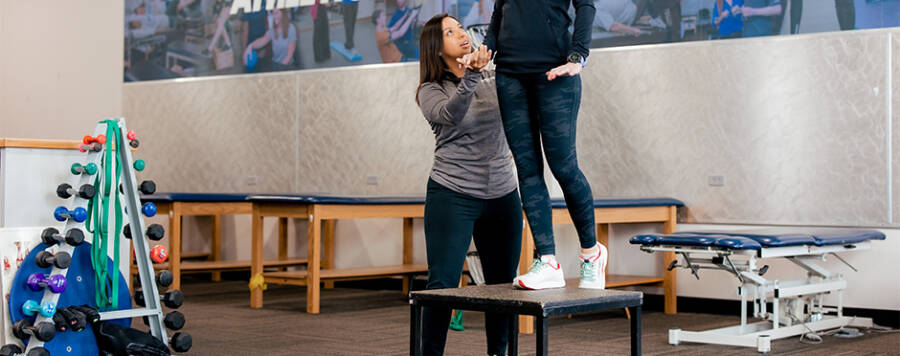PT After The First Fall
Falling one time is not necessarily a red flag because accidents happen all the time. Specifically, if it is a person’s first fall, and it is related to tripping over something or slipping on ice, it may have simply been unlucky versus indicating that someone has balance impairments. However, if someone has concerns after falling during daily activities and would like to address their concerns about balance or strength, physical therapists often offer balance assessments to help someone determine if they have a problem which requires intervention.
Physical therapists are trained in performing balance screening tests that help to determine if someone is at a risk of falling in the future or if they would be safer using an assistive device such as a cane. A physical therapist will also commonly assess strength and coordination to inform if that may be a cause of falls. Early intervention is key when managing balance because oftentimes, if someone gets treatment sooner, they have better success overall. You never know when a fall could result in an injury.
If there are weak muscle groups or balance impairments, a physical therapist can help you to put together an exercise program to address individual needs. Physical therapists also help people to navigate their need for assistive devices such as a walker or cane if necessary.
PT To Support Someone With A History Of Falls
If someone has fallen multiple times per year at home, it is vital that they seek support, often from a physical therapist. When working with a physical therapist, they may perform tests related to strength, coordination, and function to help narrow down what specific needs must be addressed to make someone safer. A physical therapist’s evaluation may also include balance tests as well as screening a patient’s vision or their vestibular system.
An example of some of the more common balance tests performed by physical therapists include the timed up and go (TUG), Berg Balance Scale, and Activities-specific Balance Confidence (ABC) Scale. The TUG is a test of being able to stand, walk 10 ft, turn around and walk back 10 ft to sit down. Depending on how long it takes to complete this test correlates with a risk of falling. The Berg balance test consists of a variety of activities such a standing with feet together, closing your eyes, and turning in a circle. There are 14 items tested and score 0-4 points. A higher score is better and depending on the score it correlates to a persona fall risk. The ABC test is more of a written survey that captures a person confidence or lack of confidence with mobility/balance and concern of falling.
Follow up treatment sessions with a physical therapist may be prescribed when working with someone who has fallen before. Treatment may include strength, walking, and balance training as well as education for safe home exercises. Often, the focus is on functional tasks such as stepping over barriers, walking on uneven surfaces, turning quickly when walking, etc.
Sessions may continue as long as a patient is making progress and/or until they have met all goals and score well enough on tests to indicate they are at a lower risk of falling in the future.
PT For An Injury As A Result Of A Fall
Physical therapy for people that have an injury after falling focuses first on pain reduction and ensuring a person regains range of motion (ROM) and strength in the injured area. Pain and fear are common limiting factors after someone is injured from a fall. Physical therapists will work to help overcome fear and reduce pain so that patients can return to their prior level of mobility.
The balance specific training is similar to the description above considering it relates to working on strength/coordination/ and stability overall. However, there may be modifications or a different timeline for progressions after someone if injured. Often, physical therapists will communicate with your primary or referring physician on progress.
Physical therapists are trained to assist individuals who have a history of falling or concerns of falling. If you have individualized questions about balance or reducing your risk of falling, or know someone that has recently experienced a fall, connect with our team to learn more about potential next steps.
*Per federal guidelines, beneficiaries of plans such as Medicare, Medicaid, Tricare, VHA and other federally funded plans are not eligible for free assessments.
The Athletico blog is an educational resource written by Athletico employees. Athletico bloggers are licensed professionals who abide by the code of ethics outlined by their respective professional associations. The content published in blog posts represents the opinion of the individual author based on their expertise and experience. The content provided in this blog is for informational purposes only, does not constitute medical advice and should not be relied on for making personal health decisions.
References:
“Berg Balance Scale.” Physiopedia, www.physio-pedia.com/Berg_Balance_Scale. Accessed 27 June 2023.
Ben Kenuk, PT. “The Activities-Specific Balance Confidence (ABC) Scale.” Mobile Measures, 23 Feb. 2021, mobilemeasures.org/2021/02/05/the-activities-specific-balance-confidence-abc-scale/#:~:text=Scoring%20the%20ABC%20Scale&text=Scores%20range%20from%200%20to,confidence%20in%20their%20balance%20ability.
Zachary Vandenberg has been a physical therapist for over 7 years with a broad range of experience treating orthopedic, vestibular, neuro, and chronic pain populations. He graduated from Marquette University in Milwaukee WI and is now a clinic manager in Northeast WI. In his free time he enjoys biking, live music, and working in the yard.

 width="900"
height="356"
>
width="900"
height="356"
>
